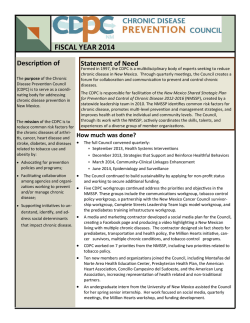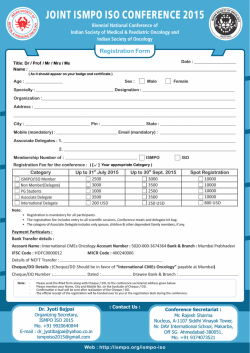
(PBM) Collaborative - National Blood Authority
National Patient Blood Management (PBM) Collaborative Information Bulletin January 2015 National PBM Collaborative - Anaemia Management for Patients Having Elective Surgery The Australian Commission on Safety and Quality in Health Care (the Commission) has been engaged by the Australian Government Department of Health to lead a Na onal Pa ent Blood Management (PBM) Collabora ve focussing on Anaemia Management for Pa ents Having Elec ve Surgery. Three categories of surgery will be considered: abdominal, gynaecological and orthopaedic procedures. The aim of the Na onal PBM Collabora ve is to achieve rapid and sustainable improvements in outcomes for pa ents through PBM. The Collabora ve learning method involves focussing on an important issue in healthcare where further improvements are possible. It is a structured process that will enable hospitals to learn from each other and from recognised experts in PBM. The Na onal PBM Collabora ve will have four components: iden fica on of specific and measurable aims; measurement of improvements over me; iden fica on of changes that facilitate the desired improvements; and, a series of learning cycles where teams implement iden fied changes. The Na onal PBM Collabora ve will consider and incorporate: the six evidence based PBM Guidelines now being delivered to health providers through the Na onal Blood Authority’s (NBA) PBM educa on, training and promo on program; the experience of the Western Australian PBM Program which has in par cipa ng hospitals, within four years of implemen ng a PBM Program, achieved a 13% drop in the transfusion issuances; and the growing evidence of a dose dependent increase of morbidity and adverse outcomes associated with transfusion which may also be increasing the length and complexity of hospital admissions. Apply now to be part of the National PBM Collaborative Expressions of Interest (EOI) are being sought from public and private hospitals to par cipate in the Na onal PBM Collabora ve: Anaemia Management for Pa ents Having Elec ve Surgery, which will run from March 2015 to April 2017. Three categories of surgery will be considered: abdominal, gynaecological and orthopaedic procedures. Health services may wish to include more than one category of surgery, and it will be important for health services to consider the volume of surgery required to ensure clinical quality improvement can be achieved. The Commission will provide support to successful respondents to achieve the objec ves set locally for improved pa ent care through PBM strategies. As General Prac oners and primary health clinicians play a key role in the overall health management of these pa ents, Expressions of Interest that involve partnerships with primary care providers and organisa ons will be strongly supported. Joint projects between public and private hospitals will also receive favourable considera on. Download the Registra on Form from: www.safetyandquality.gov.au/na onal-priori es/pbm-collabora ve/ Email: pbmcollabora [email protected] Phone: (02) 9126 3648 EOIs must be received by Friday 30 January 2015. National PBM Collaborative - Anaemia Management for Patients Having Elective Surgery (continued) Page 2 The Na onal PBM Collabora ve is progressing in consulta on with the NBA and the states and territories. PBM has been iden fied as a clinical area with poten al to improve pa ent outcomes. Blood and blood products are a vital resource, sourced from the Australian and interna onal donor community, and from commercial manufacturers. They are important elements of clinical prac ce and of great benefit to pa ents. While blood and blood products can be lifesaving, there are also hazards associated with their administra on to pa ents. These hazards include allergic and immunological complica ons, storage-related complica ons, infec ons, incorrect blood transfusions and other adverse outcomes. Research has also indicated that a significant propor on of blood transfusions may be unnecessary or could have been avoided. There is also high varia on in prescribing prac ce in rela on to blood and blood products. A systema c review of evidence has found that preopera ve anaemia is independently associated with an increased risk of morbidity and mortality. Preopera ve anaemia has also been found to increase the likelihood of red blood cell transfusion. Anaemia management prior to elec ve surgery can improve a pa ent’s pre-surgery clinical status, and reduce post-surgery morbidity, mortality and length of stay in hospital. For a pa ent’s wellbeing, it is important to establish a defini ve diagnosis of anaemia; whether it is related to the pa ent’s current condi on; and, if it is correctable. While some forms of anaemia cannot be prevented (if caused by a failure in the cell produc on process), other forms, such as anaemia caused by blood loss and dietary deficiency, can be prevented and managed. Unless there is a primary disorder of the marrow or some influence suppressing marrow func on, most forms of anaemia are correctable without red blood cell transfusion within two or three weeks. If surgery is urgent, red blood cell transfusion may be provided. However, anaemia may recur in the weeks following surgery. If red blood cell transfusion is used to correct anaemia in the short term, the cause of the anaemia will need to be followed up and/or the anaemia monitored to ensure it is resolved. There has been an increasing focus on PBM over the last decade. In conjunc on with the clinical community, the NBA developed a series of evidence-based Guidelines to support healthcare professionals in making clinical decisions in regard to blood and blood products. Implementa on of these Guidelines aims for be er outcomes for pa ents. Jurisdic ons have also been ac ve in improving PBM and have established programs using both locally developed and NBA strategies. A key aspect will be bringing together par cipant sites with experts in PBM, quality improvement and Collabora ve methodologies. An orienta on workshop will be held to: develop a shared understanding of PBM and its importance; share knowledge of current ini a ves and research; provide training in collabora ve methodologies and quality improvement tools; develop changes strategies to be trialled locally; confirm the measures to be used to assess the impact of changes; and methods for collec ng data to assess the impact of those changes. Learning Workshops will provide an opportunity for teams from par cipant sites to share their experiences, including the impact of changes introduced. Par cipa ng sites will also receive ongoing support through regular teleconferences and web access for informa on exchange. The Na onal PBM Collabora ve will fast-track the benefits of PBM protocols, guidelines and programs. References A patient’s blood is a valuable and unique natural resource that should be conserved and www.blood.gov.au/pubs/pbm/module2/3-clinical-guidance/3.2effect-of-anaemia-on-outcomes.html www.transfusion.com.au/adverse_transfusion_reac ons appropriately managed. PBM provides a structured process Rubin, G, Frommer M et al. Appropriateness of red blood cell transfusions in major urban hospitals and effec veness of an interven on. Med J Aust 2001 175: 354 - 358 where the focus is on good patient care and optimising this resource. Page 3 Planning Workshop, September 2014 A Workshop was held on 22 September 2014, with members of the PRG, Department of Health and subject ma er experts in PBM, policy and Collabora ve methodology a ending. The aim of the Workshop was to advise on: the scope of the Na onal PBM Collabora ve; focus areas; the criteria and process for site selec on for the Collabora ve. The Commission established a PBM PROJECT REFERENCE GROUP (PRG) to provide technical advice and strategic oversight throughout the Collabora ve. There was general support at the Workshop for resources to be provided in a flexible way, so as to meet the specific needs of individual project sites, whilst also mee ng the overall requirements of the Na onal PBM Collabora ve. A key process objec ve of the Na onal PBM Collabora ve is to streamline data collec on and develop performance metrics relevant to PBM. There is a need to incorporate both pa ent and product focused performance measures. An EXPERT PANEL will also provide support and exper se across a range of clinical quality improvement and health service delivery areas. Key findings of the Workshop were: Scope of PBM PBM is a mul disciplinary approach to pa ent care that aims to minimise exposure to unnecessary blood or blood products with the objec ve of improving pa ent outcomes. This can be achieved by: op mising blood volume and red cell mass; minimising blood loss; and, op mising the pa ent’s tolerance of anaemia. Collaborative Focus The Workshop recommended that the priority area for the PBM Collabora ve should be Anaemia Management for Pa ents Having Elec ve Surgery. Number of participating sites The target number of par cipa ng sites should be up to 15 sites, with flexibility as to how support is structured for each site and dependent on budget and cost. Collaborative timetable and testing cycles A successful Collabora ve requires a significant planning and preimplementa on phase. Selec on of par cipa ng sites Selec on criteria for par cipa ng sites should include: ins tu onal support, with CEO sign -off; being part of a surgical network or the elec ve surgery referral pathway; commitment to an exis ng, or to the establishment of a project governance commi ee with nominated responsible senior execu ve staff; commitment to staff par cipa on in Collabora ve ac vi es; and ability to collect, analyse and share data. Partnerships and collabora ons with other individuals and organisa ons, should be encouraged. Resources and support for participating sites The Na onal PBM Collabora ve will provide the support framework for the Collabora ve program’s tes ng, learning and feedback cycles. Funding arrangements for Collabora ve sites should be flexible and responsive to local needs. Data extraction and analysis Performance metrics for individual Collabora ve sites and for jurisdic ons should be agreed in the pre-implementa on phase. An evalua on framework, encompassing qualita ve and quan ta ve elements, should be developed for the Na onal PBM Collabora ve. Measures Group, November 2014 To further advance decisions about data extrac on, collec on, analysis and performance metrics, a Measures mee ng was held in November 2014. There was agreement that the maximum benefit from the Na onal PBM Collabora ve could be achieved if the clinical caseload was more focussed on elec ve surgery pa ents most likely to be anaemic, have iron deficiency, or require a red blood cell transfusion. A list of surgical procedures developed by the Department of Health in Western Australia provided guidance as to the procedures that could be a focus for the Na onal PBM Collabora ve. The Measures Group proposed that the Na onal PBM Collabora ve should focus on procedures associated with orthopaedic, abdominal and gynaecological surgery. It was highlighted that it would be important to demonstrate the impact of the Na onal PBM Collabora ve on overall health service resource use and performance. It is expected that analysis of de-iden fied pa ent level data which includes diagnosis; co-morbidi es (especially ischaemic heart disease, chronic renal failure and diabetes); length of stay; and, complica ons will add considerably to best understanding the impact of the Na onal PBM Collabora ve. Whilst the mee ng enabled a clear direc on in regard to Measures, further work will be undertaken to document the indicators for this Na onal PBM Collabora ve and review other technical considera ons. Frequently Asked Questions regarding the National PBM Collaborative How will the Na onal PBM Collabora ve help health services? Par cipa ng in the Na onal PBM Collabora ve will contribute to : strengthened compliance with NSQHS Standard 7: Blood and Blood Products implementa on of Na onal Blood Authority’s Pa ent Blood Management Guidelines con nuous quality improvement in the work of the health service enhanced data collec on to support service improvement, accredita on and compliance informing the development of local strategies to strengthen the elec ve surgery referral and treatment pathway the development of local leaders, and enhanced clinical engagement to support quality improvement in the health service. What is the structure of the Na onal PBM Collabora ve? The Na onal PBM Collabora ve is expected to start in March 2015 and con nue un l April 2017. An orienta on will formally commence the Collabora ve and explain key concepts and requirements for par cipa on. There will be up to six Learning Workshops throughout the Collabora ve. A er each Learning Workshop, Ac on Periods are held during which teams test ideas for improvement using the model for improvement (Plan, Do, Study, Act Cycles – PDSAs). By tes ng ideas, monitoring ac vity and repor ng on progress against targeted aims teams will be able to determine which ideas are successful and if they could lead to broader sustainable informa on. This informa on will feed into the next learning cycle. The workshops will allow teams to share their experiences of local quality improvement processes; learn from colleagues; consult with experts in the field; gather new informa on; and develop ideas for improvement. During Ac on Periods, teams will work towards implemen ng ideas within their health service, while maintaining contact with each other to share progress and improvements, monitor ac vity and report against targeted aims on a monthly basis. What support and resources will be provided? The Commission will provide : orienta on and Learning Workshops travel and accommoda on, for up to three key staff, to a end the Orienta on and Learning Workshops PBM educa on, training and tools, including: web interface for communica on and transfer of data; analy cal support and genera on of performance reports; PBM forums for ongoing discussions and communica on; and expert support, available both on-site and through web applica ons In addi on, a package of resources to support the individual needs of each team will be developed. This may include funding to contribute to the appointment of project staff, or employee backfill to a end the Collabora ve ac vi es. What is required of the project team and health service? The health service is the provider, or part of a service network, which undertakes elec ve surgery. Demonstrated ins tu onal support for par cipa on in the Collabora ve, with Chief Execu ve Officer sign-off. Demonstrated commitment to project governance through a new or exis ng commi ee, which includes par cipa on by nominated senior execu ve staff. Nominated key staff must include a senior clinical lead, clinician and project officer. The health service should also commit the necessary resources to support the conduct of the Collabora ve and enable nominated key staff to a end the orienta on and Learning Workshops. Key staff will need to have dedicated me to work on PBM during Learning Cycles and submits appropriate reports and data against targeted aims during each Ac on Period. The health service should determine and organise any approvals that may be required in regards to ethics and other ma ers. Health services will need to consider the volume of surgery undertaken so clinical quality improvement can be achieved. Health services should indicate a minimum threshold for each of the categories of surgery they will be including for the Collabora ve.
© Copyright 2025









